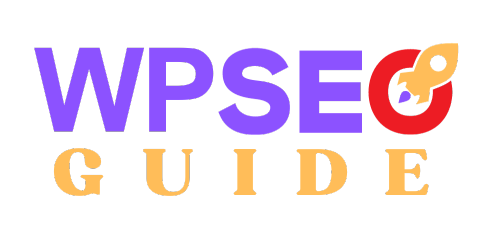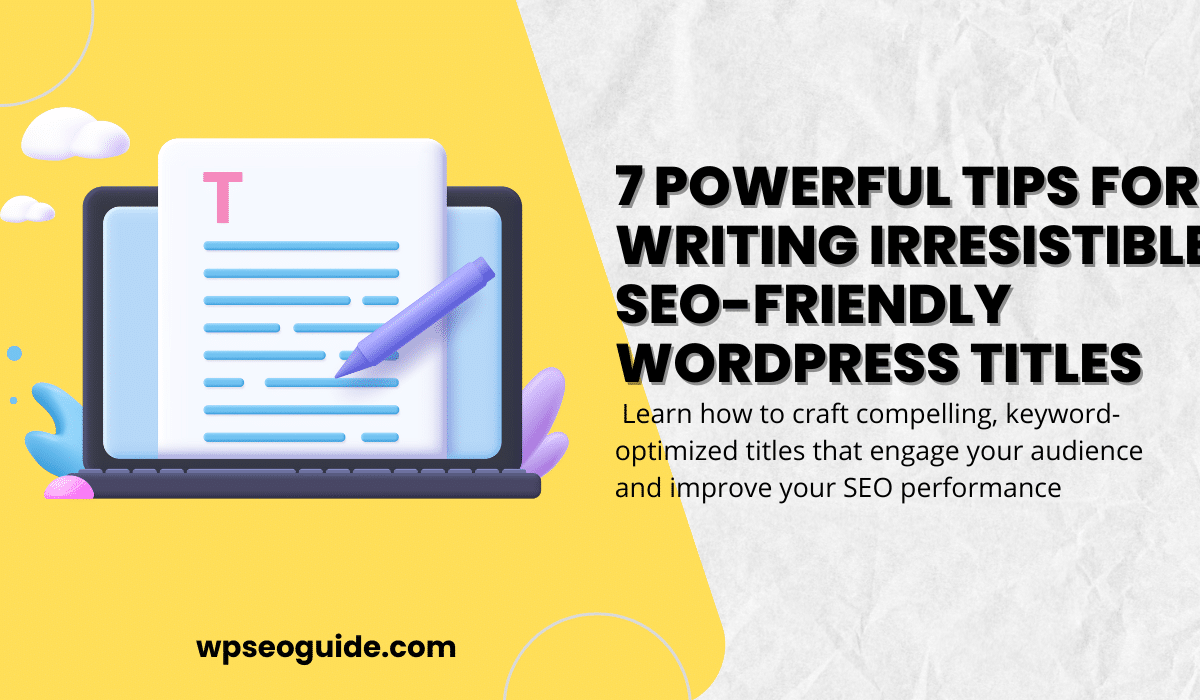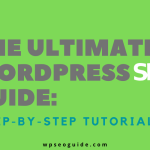SEO-Friendly WordPress Titles: How They Boost Your Click-Through Rate (CTR)
SEO-friendly WordPress titles are a game-changer when it comes to improving your Click-Through Rate (CTR). Simply put, CTR is the percentage of people who click on your link after seeing it. The better your titles, the more likely people are to click—and that means more traffic to your site. Search engines like Google also take CTR into account when deciding how to rank your pages. So, by crafting compelling, SEO-friendly titles, you’re not just attracting visitors, you’re also improving your chances of ranking higher and driving even more organic traffic.
Objective of the Article
The purpose of this article is to provide you with effective strategies for crafting irresistible SEO-friendly WordPress titles that maximize your CTR. By understanding the elements of a compelling title and implementing proven techniques, you can enhance your content’s attractiveness and engagement. This guide will cover the key components of an effective title, practical writing techniques, tools for optimization, and real-life examples to illustrate successful strategies. Whether you’re a seasoned marketer or a beginner, this article aims to equip you with the knowledge to boost your CTR and improve your website’s performance.
Section 2: Understanding the Elements of a Compelling SEO-Friendly WordPress Title
Relevance
Relevance is the cornerstone of a compelling title. Your title should accurately reflect the content of your article, ensuring that it meets the audience’s expectations. Misleading titles may initially attract clicks, but they can lead to high bounce rates and damage your credibility. A relevant title helps build trust with your readers and encourages them to engage with your content.
Clarity
Clarity is essential in making your titles easily understandable. Avoid using ambiguous or complex language that might confuse your audience. A clear, straightforward title helps potential readers quickly grasp the subject of your article, increasing the likelihood of a click. Aim for simplicity and precision to ensure your message is conveyed effectively.
Keyword Optimization
Keywords play a vital role in SEO and should be incorporated into your titles strategically. Including relevant keywords helps search engines understand the topic of your content, improving its visibility in search results. However, it’s important to balance keyword usage with readability. Overstuffing titles with keywords can make them sound unnatural and deter potential readers.
Emotional Appeal
Emotional appeal is a powerful tool in creating irresistible titles. By triggering curiosity, excitement, or urgency, you can capture the reader’s attention and compel them to click. Use power words and emotional triggers to make your titles more engaging. For example, words like “ultimate,” “essential,” or “unbelievable” can evoke strong emotions and attract clicks.
Length
The length of your title can impact both readability and SEO. Ideally, your title should be between 50-60 characters to ensure it displays fully in search engine results and social media shares. Titles that are too long may get cut off, while very short titles might not provide enough information. Striking the right balance in title length helps maintain clarity and effectiveness across different platforms.
Section 3: Techniques for Writing Irresistible SEO-Friendly WordPress Titles
Use of Numbers and Lists
Titles that include numbers and lists are particularly effective at grabbing attention. People are naturally drawn to numbers because they suggest a clear, organized structure and promise specific takeaways. For example, “10 Tips for Boosting Your WordPress SEO” or “5 Reasons Your CTR is Dropping.” Such titles convey a sense of value and make it easier for readers to scan and understand the content.
Questions
Posing a question in your title can engage readers by appealing to their curiosity. Questions make readers pause and consider the answer, which can drive them to click on your article to find out more. For example, “Are You Making These Common WordPress Mistakes?” or “What Makes a Good WordPress Title?” Questions create a sense of interaction and can be highly effective in encouraging clicks.
How-to Guides
How-to titles are highly appealing because they promise practical advice and solutions to specific problems. These titles attract readers who are looking for actionable steps to achieve a particular goal. Examples include “How to Improve Your WordPress Site’s Loading Speed” or “How to Write SEO-Friendly Blog Posts.” How-to guides are popular among readers seeking to learn and apply new skills.
Use of Adjectives and Superlatives
Incorporating descriptive adjectives and superlatives can make your titles more enticing. Words like “ultimate,” “essential,” “unbelievable,” and “best” add emphasis and appeal to the reader’s desire for high-quality content. For example, “The Ultimate Guide to WordPress Security” or “7 Unbelievable Tricks to Boost Your CTR.” These words enhance the perceived value of your content and attract more clicks.
Incorporating Trends and Buzzwords
Staying relevant by incorporating current trends and buzzwords into your titles can significantly boost your CTR. Trending topics and popular buzzwords catch the audience’s attention and make your content appear timely and relevant. For example, “Boost Your SEO in 2024 with These New WordPress Plugins” or “The Latest WordPress Trends You Need to Know.” Keeping up with trends helps your content resonate with current audience interests.
Section 4: Tools and Resources for Title Optimization
Title Generators
Title generators are valuable tools for brainstorming and creating engaging titles. These tools use algorithms to suggest multiple title options based on keywords or topics you input. Popular title generator tools include:
- Portent’s Content Idea Generator: Offers creative and sometimes humorous title suggestions to grab attention.
- SEMrush Title Generator: Provides SEO-focused titles with keyword integration.
- HubSpot Blog Ideas Generator: Generates a week’s worth of title ideas based on five nouns.
Using these tools can save time and spark new ideas, but it’s essential to tweak the suggestions to ensure they align with your content and audience.
A/B Testing
A/B testing involves comparing two versions of a title to see which one performs better in terms of CTR. By testing different titles for the same content, you can identify the most effective wording and structure. To conduct A/B tests:
- Create Two Title Variations: Develop two distinct titles for the same content.
- Split Your Audience: Divide your audience into two groups, each seeing one of the titles.
- Analyze Results: Compare the CTRs of both groups to determine the more effective title.
Tools like Google Optimize or Optimizely can help streamline the A/B testing process.
Headline Analyzers
Headline analyzers evaluate the effectiveness of your titles by scoring them based on various factors such as length, sentiment, and readability. These tools provide feedback and suggestions for improvement. Notable headline analyzers include:
- CoSchedule Headline Analyzer: Scores titles based on word balance, headline type, and readability.
- Sharethrough Headline Analyzer: Assesses titles for engagement and provides suggestions to enhance them.
- Advanced Marketing Institute’s Emotional Marketing Value Headline Analyzer: Measures the emotional impact of your titles.
Using these analyzers can help you refine your titles to maximize their appeal and effectiveness.
Section 5: Case Studies and Examples of SEO-friendly WordPress titles
Successful Titles from Popular Websites
Analyzing high-performing titles from popular websites can provide insights into what makes a title effective. Here are some examples and their key attributes:
- BuzzFeed: “21 Things Only People Who Work From Home Will Understand”
- Key Attributes: Use of a list format, targeting a specific audience, creating a sense of belonging.
- The New York Times: “How to Make the Best Chocolate Chip Cookies”
- Key Attributes: How-to format, promise of the “best” outcome, targeting a popular interest.
- Neil Patel: “The Ultimate Guide to Content Marketing in 2024”
- Key Attributes: Use of “ultimate guide,” timely relevance, comprehensive scope.
By studying these titles, you can identify patterns and techniques to apply to your own title creation process.
Before and After seo-friendly Title Optimization
Real-life examples of title improvements can illustrate the impact of optimization on CTR:
- Before: “Improve Your WordPress Site”
- After: “10 Proven Tips to Instantly Boost Your WordPress Site’s Performance”
- Impact: The optimized title is more specific, includes a number, and promises instant results, leading to a higher CTR.
- Before: “SEO Tips for Beginners”
- After: “7 Essential SEO Tips Every Beginner Needs to Know”
- Impact: The optimized title uses a number, adds an adjective (“essential”), and specifies the target audience, making it more compelling.
These examples demonstrate how small changes can make a significant difference in attracting clicks.
Section 6: Best Practices in SEO titles optimization for Ongoing Improvement
Regular Updates and Revisions
Keeping your titles fresh and relevant is crucial for maintaining high CTR. Regularly updating and revising your titles can ensure they remain aligned with current trends and audience interests. To identify titles that need improvement:
- Monitor Performance: Use analytics tools to track the performance of your titles.
- Identify Low Performers: Look for titles with low CTRs and consider revising them.
- Refresh Old Content: Periodically update titles for older content to keep it engaging.
Monitoring Performance
Tracking the performance of your titles helps you understand what works and what doesn’t. Tools like Google Analytics, [Ahrefs](https://ahrefs.com/), or SEMrush can provide insights into CTR, traffic, and engagement metrics. Analyzing this data enables you to make informed decisions and refine your title creation strategy. Read more about google analytics and how to add google analytics to your wordpress website
Staying Informed About SEO Trends
SEO best practices and trends evolve, so it’s essential to stay informed about the latest developments. Follow industry blogs, attend webinars, and participate in forums to keep up-to-date with changes in SEO and content marketing. Resources such as Moz, Search Engine Journal, and HubSpot offer valuable insights and updates on SEO trends.
By implementing these best practices, you can continuously improve your title writing skills and maintain high CTR, ensuring your content remains engaging and effective.
Section 7: Conclusion
Recap of Key Points
Crafting irresistible WordPress titles is crucial for maximizing CTR and driving organic traffic. Throughout this article, we have explored several essential elements and techniques for creating effective titles:
- Understanding the importance of relevance, clarity, keyword optimization, emotional appeal, and appropriate length.
- Utilizing specific strategies such as incorporating numbers and lists, posing questions, offering how-to guides, and using adjectives and superlatives.
- Leveraging tools and resources like title generators, A/B testing, and headline analyzers for title optimization.
- Learning from successful titles and real-life examples to enhance your own title creation process.
- Regularly updating and revising titles, monitoring performance, and staying informed about SEO trends for ongoing improvement.
Encouragement to Experiment
While the strategies and techniques discussed provide a solid foundation, the key to mastering title creation is experimentation. Don’t hesitate to try different approaches and analyze their impact on your CTR. What works for one audience or piece of content may not work for another, so continuous testing and adaptation are essential.
Call to Action
Now that you are equipped with the knowledge to craft irresistible WordPress titles, it’s time to put these strategies into practice. Start by analyzing your current titles, applying the techniques discussed, and monitoring their performance. Share your experiences and tips for writing effective titles in the comments section, and let’s continue the conversation on how to boost CTR and improve content engagement.
Section 8: Additional Resources
Recommended Reading
- “Everybody Writes” by Ann Handley: A guide to creating content that attracts and retains audience attention.
- “Made to Stick” by Chip Heath and Dan Heath: Insights into why some ideas and messages thrive while others fail.
- “The Art of SEO” by Eric Enge, Stephan Spencer, and Jessie Stricchiola: Comprehensive coverage of SEO strategies, including optimizing titles for better search performance.
Tools and Plugins
- Yoast SEO: A popular WordPress plugin that helps optimize your titles and meta descriptions for better SEO.
- SEMrush: A comprehensive tool for keyword research, SEO analysis, and title optimization.
- Headline Studio by CoSchedule: A tool to analyze and improve your headlines for maximum engagement.
Section 9: FAQ
What is CTR and why is it important?
CTR, or Click-Through Rate, is the percentage of users who click on a specific link out of the total users who view the page. It’s a critical metric for measuring the effectiveness of your titles and content in attracting audience engagement. Higher CTR indicates that your titles are compelling and relevant, which can lead to increased traffic and improved SEO rankings.
How long should my WordPress titles be?
Ideally, your titles should be between 50-60 characters. This length ensures that your titles are concise enough to be easily read and fully displayed in search engine results and social media shares. Longer titles might get cut off, while very short titles might not provide enough information to entice clicks.
How can I use keywords effectively in my titles?
Incorporate relevant keywords naturally within your titles to improve SEO without compromising readability. Place the primary keyword at the beginning of the title if possible, and avoid keyword stuffing. Balancing keyword optimization with an engaging and clear title is key to attracting both search engines and readers.
What are some examples of power words to use in titles?
Power words are emotionally charged words that can make your titles more compelling. Examples include “ultimate,” “essential,” “proven,” “unbelievable,” “secret,” and “exclusive.” These words evoke curiosity, urgency, and excitement, which can increase the likelihood of clicks.
How often should I update my titles?
Regularly review and update your titles to ensure they remain relevant and effective. Aim to refresh older content periodically, especially if it experiences a drop in traffic or engagement. Monitoring performance metrics can help identify when a title needs revision.
By following these guidelines and continuously refining your approach, you can create irresistible WordPress titles that maximize CTR and drive consistent traffic to your site.





